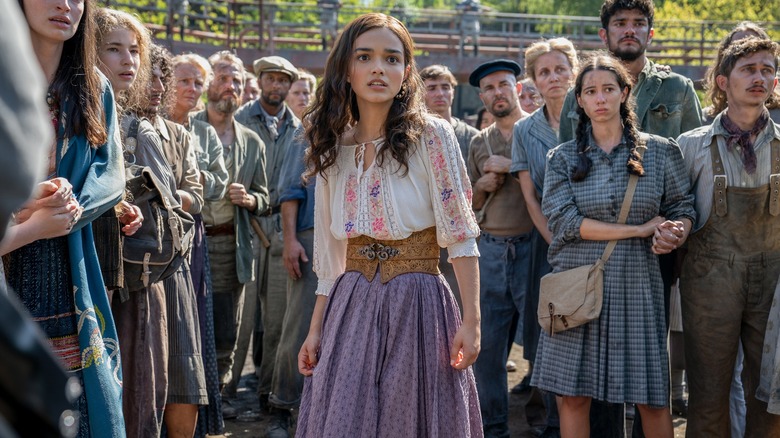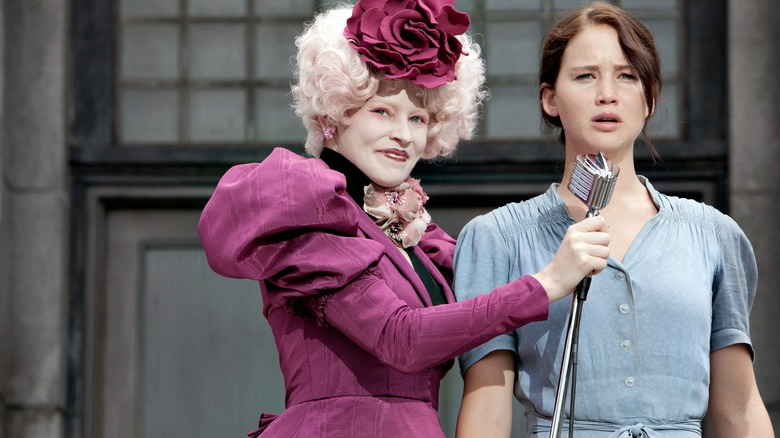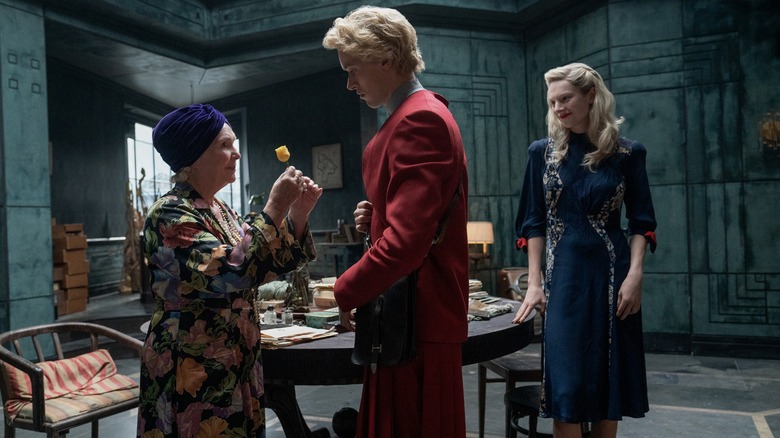The Correct Order To Watch The Hunger Games Movies
Suzanne Collins knows how to write a dystopia. The "Hunger Games" series and its prequel "The Ballad of Songbirds and Snakes," are among the most intense and shocking books released under the "young adult" label this side of the 21st century. They get surprisingly real about topics like PTSD, propaganda, wealthy inequality, and the slow creep of fascism, presenting all of the above in a compelling, shiny package that's thrilling for both teens and grown-ups alike.
The movie adaptations of "The Hunger Games," for the most part, do all that too, but some entries in the property are certainly better than others. With five films to date in the franchise (and no more planned, unless Collins surprises us with another book), each one is essential, but there are actually multiple ways in which to watch them for maximum impact. If you've never seen "The Hunger Games" or are wondering whether it's possible to get started with the prequel first, let us be your guide — your mentor, if you will — through this treacherous world.
Option one: narrative chronological order
In terms of adhering to in-world chronology, the ideal way to watch "The Hunger Games" movies is by starting with the prequel — the most recent film "The Ballad of Songbirds and Snakes" — before following it up with the original quartet. That is, watch "Songbirds and Snakes," followed by "The Hunger Games," then "Catching Fire," then "Mockingjay" parts 1 and 2.
The prequel takes place during the 10th annual Hunger Games while Katniss' story begins at the 74th games, meaning "Songbirds" is set 64 years before the original series. In the prequel, the North American country known as Panem is still relatively young, and its government is still coming up with creative and ruthless ways to keep citizens oppressed. Rebel groups still exist, as do vibrant cultures that haven't yet been stamped out by the Peacekeepers. By the 74th games, though, Panem is a totalitarian government from which escape seems impossible, and "The Ballad of Songbirds and Snakes" explains how that governmental grip tightens.
The film also provides essential backstory for the book trilogy's main villain, President Corialanus Snow (Donald Sutherland as an adult, Tom Blyth in his younger years). Before he was a dictator, Coryo was an ambitious but half-starved kid trying to pass as one of the wealthy elites of the Capitol. How did Snow go from a hottie with a heart to an old creep who everyone wishes was dead? It has something to do with a folk singer named Lucy Gray (Rachel Zegler), and by the end of the ample runtime of "Ballad of Songbirds and Snakes," it'll all make sense.
Option two: release date order
There's also a more interesting and potentially rewarding order in which to watch "The Hunger Games," and it's by starting with the original movie quartet — "The Hunger Games," "Catching Fire," and "Mockingjay" parts 1 and 2 — before catching the new movie. This may seem counterintuitive, but it's actually the way the series was designed.
It's very possible to care about the story told in "The Ballad of Songbirds and Snakes" even if you haven't seen "The Hunger Games," but the movie relies on viewers' knowledge of this word — particularly of the rules of the later Hunger Games — for maximum impact. The game's primitive design choices and features, its burgeoning cultural impact, and entire characters like Lucretius "Lucky" Flickerman (Jason Schwartzman) work better when you know what a garish spectacle this tradition will turn into in 60+ more years.
The 10th annual games also presents a set of character types (like the bully, the defenseless sweetheart, and the strong silent type) that readers and fans of the original trilogy will recognize. Meeting these characters after watching the first four "Hunger Games" films makes their choices and fates all the more surprising, as we get to see some of our expectations as repeat "Hunger Games" viewers subverted. Collins clearly wrote the prequel novel with this reading order in mind, hoping to surprise longtime readers of the franchise by taking the familiar and turning it on its head.
Some prequels are meant to be watched last, actually
You don't have to watch the original "Hunger Games" films before seeing "The Ballad of Songbirds and Snakes," but doing so makes for a more complex viewing experience. The movie makes references to ideas, symbols, and bits of mythology that would only mean anything to someone who's seen the other films. Fans of the original "Hunger Games" films and book series will also head into the prequel convinced nothing could make them sympathize with Snow, but will quickly be reminded that even the most inhumane people in the world start off human.
On that note, watching these movies in release order has a sobering effect for anyone who's witnessed the erosion of democracy (American and otherwise) in the decade since the first film arrived. This is a romantic, violent epic, yes, but it's also a cautionary tale about the ways in which fascism and authoritarianism can grow right in front of our eyes in a way that's both sinister and wholly stoppable. The "Hunger Games" book trilogy made sense for the time in which it was written, but the greed and hunger for power on display in "Songbirds and Snakes" — and the complete lack of true heroes in positions of power — make it truly a story for the present moment.
By watching the first four films and then the prequel, you'll be held captive both by the world of Panem and by the understanding that every fantastical dystopic world is created around a kernel of unsettling real-world truth. Also, you'll get Lucy Gray's references to Katniss the swamp potato.
"The Hunger Games: The Ballad of Songbirds and Snakes" is currently playing in theaters.



